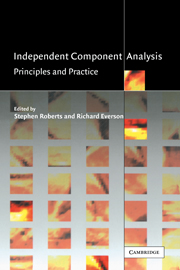Book contents
- Frontmatter
- Contents
- Preface
- Contributors
- 1 Introduction
- 2 Fast ICA by a fixed-point algorithm that maximizes non-Gaussianity
- 3 ICA, graphical models and variational methods
- 4 Nonlinear ICA
- 5 Separation of non-stationary natural signals
- 6 Separation of non-stationary sources: algorithms and performance
- 7 Blind source separation by sparse decomposition in a signal dictionary
- 8 Ensemble Learning for blind source separation
- 9 Image processing methods using ICA mixture models
- 10 Latent class and trait models for data classification and visualisation
- 11 Particle filters for non-stationary ICA
- 12 ICA: model order selection and dynamic source models
- References
- Index
6 - Separation of non-stationary sources: algorithms and performance
Published online by Cambridge University Press: 05 July 2014
- Frontmatter
- Contents
- Preface
- Contributors
- 1 Introduction
- 2 Fast ICA by a fixed-point algorithm that maximizes non-Gaussianity
- 3 ICA, graphical models and variational methods
- 4 Nonlinear ICA
- 5 Separation of non-stationary natural signals
- 6 Separation of non-stationary sources: algorithms and performance
- 7 Blind source separation by sparse decomposition in a signal dictionary
- 8 Ensemble Learning for blind source separation
- 9 Image processing methods using ICA mixture models
- 10 Latent class and trait models for data classification and visualisation
- 11 Particle filters for non-stationary ICA
- 12 ICA: model order selection and dynamic source models
- References
- Index
Summary
This chapter shows how to take advantage of the non-stationarity of the source signals to achieve the blind separation of instantaneous mixtures. Off-line and on-line algorithms are developed based on the likelihood principle and the mutual information objective. The analysis of the achievable performance also reveals how non-stationarity and non-Gaussianity both contribute to the separability.
Introduction
This chapter addresses the problem of separating instantaneous mixtures of non-stationary sources. More to the point, we investigate how to take advantage of a possible non-stationarity of the sources in order to achieve separation.
When the source signals are modelled as i.i.d. (independently and identically distributed) sequences, blind separation can be achieved only by exploiting the non-Gaussianity of the sources. In this case, sources must be non-Gaussian to be separated; poor results are to be expected when the (marginal) distributions of source signals are too close to a Gaussian distribution. In contrast, the existence of a temporal structure in the source signals makes it possible to separate even Gaussian sources. Two types of temporal structures have been considered in the literature, each corresponding to breaking one ‘i’ in i.i.d. The first case is that of stationary signals with a temporal dependence, thus having a non-flat spectrum; these are ‘non-white’ or ‘coloured’ sequences. Identifiability is granted provided no two sources have proportional spectra (see e.g., [Pham & Garrat, 19931 or [Belouchrani et al., 19971 for more elaborate statements and some algorithms) even when the signals are normally distributed.
- Type
- Chapter
- Information
- Independent Component AnalysisPrinciples and Practice, pp. 158 - 180Publisher: Cambridge University PressPrint publication year: 2001
- 3
- Cited by

